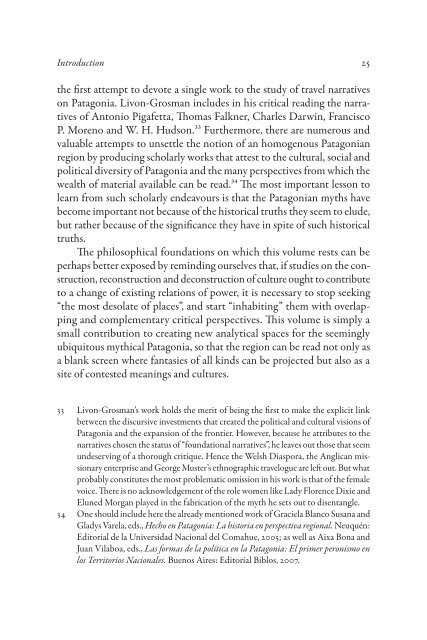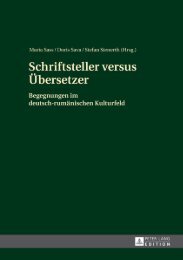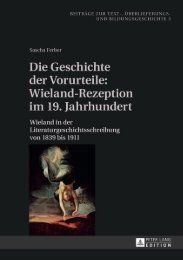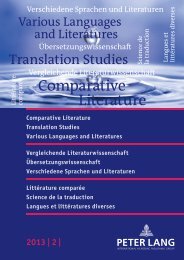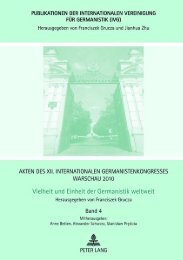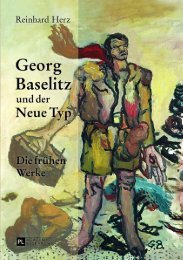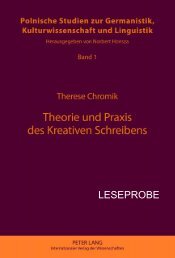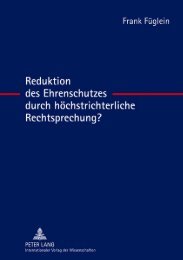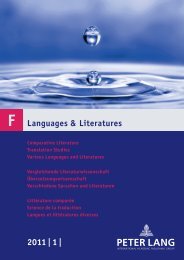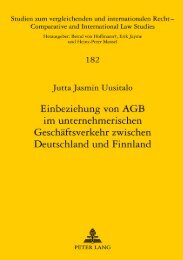Extract (PDF) - Peter Lang
Extract (PDF) - Peter Lang
Extract (PDF) - Peter Lang
You also want an ePaper? Increase the reach of your titles
YUMPU automatically turns print PDFs into web optimized ePapers that Google loves.
Introduction 25<br />
the first attempt to devote a single work to the study of travel narratives<br />
on Pata gonia. Livon-Grosman includes in his critical reading the narratives<br />
of Antonio Pigafetta, Thomas Falkner, Charles Darwin, Francisco<br />
P. Moreno and W. H. Hudson.33 Furthermore, there are numerous and<br />
valuable attempts to unsettle the notion of an homogenous Patagonian<br />
region by producing scholarly works that attest to the cultural, social and<br />
political diversity of Patagonia and the many perspectives from which the<br />
wealth of material available can be read.34 The most important lesson to<br />
learn from such scholarly endeavours is that the Patagonian myths have<br />
become important not because of the historical truths they seem to elude,<br />
but rather because of the significance they have in spite of such historical<br />
truths.<br />
The philosophical foundations on which this volume rests can be<br />
perhaps better exposed by reminding ourselves that, if studies on the construction,<br />
reconstruction and deconstruction of culture ought to contribute<br />
to a change of existing relations of power, it is necessary to stop seeking<br />
“the most desolate of places”, and start “inhabiting” them with overlapping<br />
and complementary critical perspectives. This volume is simply a<br />
small contribution to creating new analytical spaces for the seemingly<br />
ubiquitous mythical Patagonia, so that the region can be read not only as<br />
a blank screen where fantasies of all kinds can be projected but also as a<br />
site of contested meanings and cultures.<br />
33 Livon-Grosman’s work holds the merit of being the first to make the explicit link<br />
between the discursive investments that created the political and cultural visions of<br />
Patagonia and the expansion of the frontier. However, because he attributes to the<br />
narratives chosen the status of “foundational narratives”, he leaves out those that seem<br />
undeserving of a thorough critique. Hence the Welsh Diaspora, the Anglican missionary<br />
enterprise and George Muster’s ethnographic travelogue are left out. But what<br />
probably constitutes the most problematic omission in his work is that of the female<br />
voice. There is no acknowledgement of the role women like Lady Florence Dixie and<br />
Eluned Morgan played in the fabrication of the myth he sets out to disentangle.<br />
34 One should include here the already mentioned work of Graciela Blanco Susana and<br />
Gladys Varela, eds., Hecho en Patagonia: La historia en perspectiva regional. Neuquén:<br />
Editorial de la Universidad Nacional del Comahue, 2005; as well as Aixa Bona and<br />
Juan Vilaboa, eds., Las formas de la política en la Patagonia: El primer peronismo en<br />
los Territorios Nacionales. Buenos Aires: Editorial Biblos, 2007.


